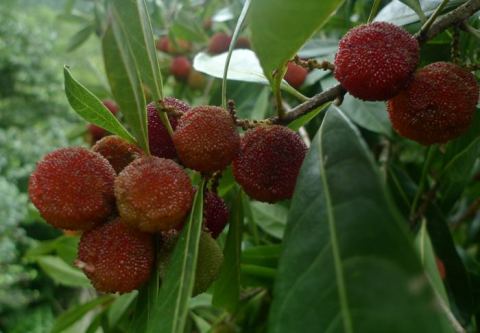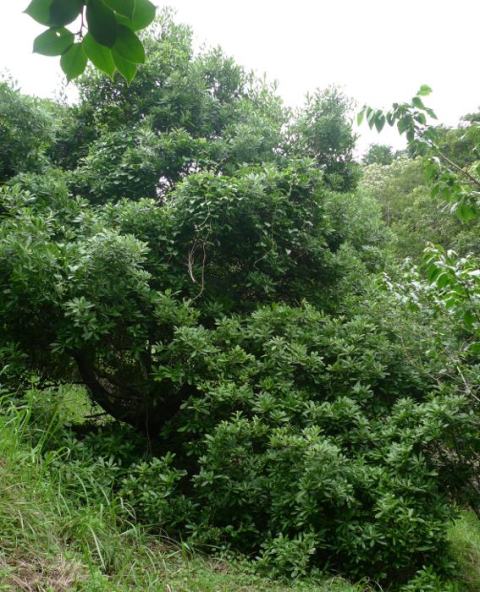A Final Farewell
April 7, 2014
Dearest readers,
it has been quite some time since I last posted anything and perhaps you wondered if I would ever post again. The answer is no, I won’t. At least not here. However, I have started a new online writing project called Thinking Like a Forest. I suspect that Asako has gone into permanent blogging retirement, though one can never be sure.
My decision to stop this blog was motivated by the host site wordpress.com’s announcement that they might start putting advertisements on free blogging sites such as this one. My opinion of advertising was shared by George Orwell: “rattling a stick in a swill bucket.” I prefer not to.
I will leave this blog online for archival purposes only. There will be no new posts from this point on. If you enjoyed it and would like to read more then I encourage you to follow Thinking Like a Forest.
P.S.
April 7, 2014
I am switching all subscribers to this blog over to the new site Thinking Like a Forest.This may be a little presumptuous so, apologies if you’re not interested. If you really don’t want to follow my move you can easily unsubscribe by following the links when you are notified of a new post.
Yamamomo
July 23, 2013
‘Tis the season for yamamomo (Myrica rubra), variously known to the English-speaking world as Chinese or Japanese bayberry, red bayberry, yumberry, Asian bog myrtle, Chinese strawberry tree or waxberry. Of these last two names the former comes from a resemblance to the strawberry tree (Arbutus unedo) and the latter because the fruit of other myrica species is coated in wax (from which candles can be made) and therefore they are known as wax myrtles or wax berries. However, despite sometimes being referred to as waxberry, the fruit of M. rubra does not have a waxy coating. A friend who lives without electricity (and thus always interested in potential sources of candle wax) has been wholly unsuccessful, despite her best attempts, in extracting any wax from M. rubra.
The Japanese name, yamamomo (山桃), means ‘mountain (yama 山) peach (momo 桃)’ although there is nothing very peach-like about the fruits of yamamomo. But then neither is there much peach-like about the native plums which are called sumomo (which once meant vinegar, or sour, (su 酸) peach (momo 桃)[1], although in contemporary Japanese sumomo is usually written 李 which obfuscates this older meaning). As far as I can see the only thing these other momo’s have in common with peaches is that they are round, stone fruits and usually red-ish.
The fruits of yamamomo are about 1.5 – 2 cm’s in diameter (there are cultivated varieties that have larger fruits however, according to local growers, the fruit is easily damaged by inclement weather at harvest time). The fruits grow in clusters and are dark red to purple when ripe. The tree is evergreen with leathery leaves and grey bark, reaching heights of 15 metres. It grows on forested mountain slopes (100 – 1500 metres) throughout southern China, Taiwan, Japan, Korea, the Philippines…[2]
The fruits are refreshingly tart and may be eaten fresh though often they are served in a sweet syrup. They also make wonderful wine (and if you can make wine you can, of course, make vinegar too). In both China and Japan they are used to make a medicinal liquor (steeped in báijiǔ in China and shōchū in Japan). See recipes below.
I have been told that, in the past, the seeds of yamamomo were also eaten in Japan. The seeds are “stones” like those of plums — although rather small they are very hard. I am yet to find out exactly how the seeds were rendered edible but I will surely update this post when I do.
The traditional medicinal uses of M. rubra by the peoples of east Asia include as an antidote for arsenic poisoning, a carminative, an anti-inflammatory, for the treatment of diarrhea, dysentery, dyspesia, nausea, excessive perspiration, psoriasis, and in the treatment of wounds, ulcers and sores.[3]
For the treatment of arsenic poisoning, wounds, sores and skin diseases a decoction of the stem bark is applied externally.[4]
The leaves have long been known to practitioners of Chinese medicine to be anti-inflammatory and recent studies have shown the juice of the fruits is also anti-inflammatory and effective in the treatment of ulcers.[5, 6]
_________________________________________________________________________________________________________
Yamamomo in syrup
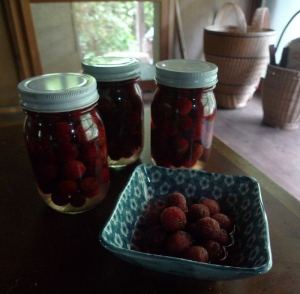 The few recipes for sweetened yamamomo that I have seen recommended cooking the fruit for 5 – 10 minutes in the syrup but I find this makes the fruit too mushy and it loses its wonderful tart edge. They also recommended an equal weight of sugar to that of the fruit – I say half that amount of sugar is plenty. I suspect these people don’t even like yamamomo!
The few recipes for sweetened yamamomo that I have seen recommended cooking the fruit for 5 – 10 minutes in the syrup but I find this makes the fruit too mushy and it loses its wonderful tart edge. They also recommended an equal weight of sugar to that of the fruit – I say half that amount of sugar is plenty. I suspect these people don’t even like yamamomo!
- Soak yamamomo in a salt brine for 30 minutes then rinse. This is to remove insects of which there are usually plenty.
- Bring sugar (half the weight of the fruit) to a boil in enough water to cover the fruit.
- Add the fruit and boil for just a couple of minutes.
- Put the fruit in jars and cover completely with the the syrup and screw on lids.
After about 24 hours they should be ready. Kept in a cool place they should keep for a month. If, once filled and capped, the jars are covered with hot water and boiled for 20 – 30 minutes the fruit should keep for up to a year. For more on processing for long term storage see here. I have attempted a batch with raw fruit — the yamamomo was not placed in the boiling syrup but directly in the jars and the hot syrup poured over the fruit — however, it started to ferment within a few days. Still tasted great though.
After finishing the fruit the syrup is used to make a very pleasant summer drink. Pour a little in the bottom of a glass and fill with cold water.
_________________________________________________________________________________________________________
Yamamomo Wine
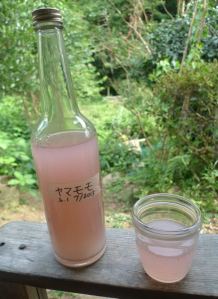 Yamamomo fruits are coated in wild yeasts which, if treated right, will happily make alcohol for you. And they’re so easy to please! Place the fruit in sugary water and stir often. As simple as that. How much sugar you use will affect the vigour and length of fermentation and thus the strength (alcohol content) of your brew. For a strong wine, use more. For 2kg of yamamomo I use about 1.25 kg’s of sugar. To make a simple “country wine” to be consumed “green”: [7]
Yamamomo fruits are coated in wild yeasts which, if treated right, will happily make alcohol for you. And they’re so easy to please! Place the fruit in sugary water and stir often. As simple as that. How much sugar you use will affect the vigour and length of fermentation and thus the strength (alcohol content) of your brew. For a strong wine, use more. For 2kg of yamamomo I use about 1.25 kg’s of sugar. To make a simple “country wine” to be consumed “green”: [7]
- Do not wash the yamamomo. You want to keep all the wild yeast on the fruit. Yes, there probably will be many tiny insects in the fruit but these will be strained out later. Place the fruit in the bottom of a container – a food grade plastic bucket or large glass jar will do nicely.
- Dissolve the sugar in enough cold water to generously cover the fruit (5 to 10 cm’s is good). Pour this mixture over the fruit in the bucket.
- Stir. And stir often. The more you can stir your potion the better. I stir my concoctions anywhere from 6 to 10 times a day. At a minimum give it at least four good stirrings every day.
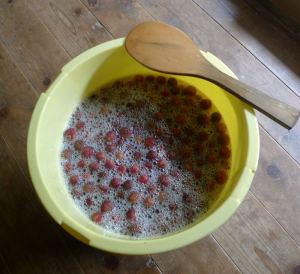
- Between stirring keep your bucket covered with a lid, cloth or anything else that keeps flies and dust out.
- After a day or two you should see bubbles or froth forming on the top of the liquid. Keep up the daily stirrings until the froth begins to lessen – hopefully this will take a couple of weeks.
- When fermentation does begin to subside strain in to bottles and enjoy.
_________________________________________________________________________________________________________
Yamamomo vinegar
Vinegar is essentially wine that has been overexposed to oxygen. Once the yeasts that converted the sugars to alcohol have begun to lose steam through lack of food acetobacter (acetic-acid-producing bacteria who were always present but until now held in check by the vigour of the yeasts) begin to dominate. It is acetobacter that will turn your wine in to vinegar.
So, to make vinegar follow the wine making steps listed above but rather than bottling the finished wine strain it into another wide mouthed container and keep covered with a cloth. Taste regularly and when it reaches the desired acidity (when it tastes like vinegar) bottle and cap. A vinegar ‘mother’ may have formed on top which you’ll need to remove before bottling. But don’t discard this. You can eat it, feed to it to your chickens or compost it.
_________________________________________________________________________________________________________
Yamamomo Koubo
Given that yamamomo is abundantly covered in wild yeasts (kõbo) it can also be used as a yeast source for bread (and probably beer too). Place some fruit in a jar, cover with water and add some honey or sugar. Stir or shake the jar often (if shaking release pressure by opening the lid after shaking). When it begins to bubble vigorously it is ready to use. For bread, just add some of the liquid to your dough mix. A little experimentation may be needed to get the amount right.
_________________________________________________________________________________________________________
Yamamomo shochu
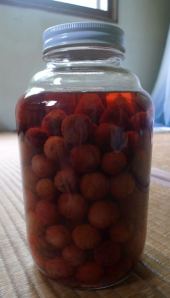 Simply steep yamamomo in liquor for a month or more. Here in Japan shōchū is typically used, in China it is báijiǔ and in Korea soju. These are all white liquors usually ranging from around 35 – 60% alcohol by volume. Vodka would be an obvious substitute. If you’re concerned about little insects in your alcohol soak the fruit in a salt brine for 30 minutes then rinse. Place the fruit in a jar and cover with liquor of your choice.
Simply steep yamamomo in liquor for a month or more. Here in Japan shōchū is typically used, in China it is báijiǔ and in Korea soju. These are all white liquors usually ranging from around 35 – 60% alcohol by volume. Vodka would be an obvious substitute. If you’re concerned about little insects in your alcohol soak the fruit in a salt brine for 30 minutes then rinse. Place the fruit in a jar and cover with liquor of your choice.
If your focus is on extracting the medicinal qualities of yamamomo then what you are making is a tincture. Fill your jar with as much fruit as possible before adding the liquor. Let it sit for at least one month and keep it out of direct sunlight. Shaking it around a bit from time to time is not a bad idea either.
If, on the other hand, you just want to flavour some liquor for drinking then less fruit/more liquor can be used.
______________________________________________________________________________________________________
References
1. https://ja.wikipedia.org/wiki/スモモ. Accessed 7/19/2013.
2. Flora of China Vol. 4. Available online at efloras.org. Accessed 7/20/2013.
3. Dr. Duke’s Phytochemical and Ethnobotanical Databases. Accessed 7/23/2013.
4. Plants for a Future, Myrica rubra. Accessed 7/23/2013.
5. Wang, S.J., et al., ‘Anti-inflammatory activity of myricetin isolated from Myrica rubra leaves.’ Planta Med 76(14), October 2010.
6. Alajmi et al., ‘Some pharmacological actions of Myrica rubra.’ African Journal of Pharmacy and Pharmacology Vol. 7(9), 8 March, 2013. PDF from Academicjournals.org. Accessed 7/23/2013.
7. For more on making country wines (or any other fermentation technique for that matter) see Sandor Katz, The Art of Fermentation. Chelsea Green, 2012.
